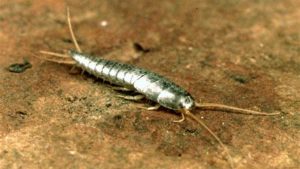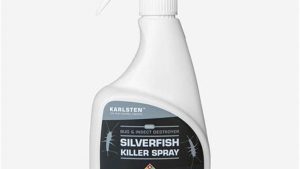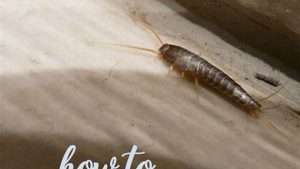Where does silverfish come from? Silverfish originate from damp environments and enter homes in search of food, such as sugars and starches found in paper and fabrics. Control moisture, repair leaks, and maintain cleanliness to prevent them.
Silverfish, small, wingless insects that feed on starches and sugars, are commonly found in homes and other buildings. Understanding their origins can help us better prevent and control infestations.
Silverfish have been around for millions of years, dating back to the Devonian period. They are believed to have originated in tropical or subtropical climates but have since adapted to a wide range of indoor environments.
Where Does Silverfish Come From
Identifying the origins of silverfish is crucial for effective pest management. Key aspects to consider include their:
- Evolutionary history
- Geographic distribution
- Habitat preferences
- Feeding habits
- Reproductive strategies
- Dispersal mechanisms
- Pest status
- Control methods
Understanding these aspects provides insights into the factors that contribute to silverfish infestations and enables the development of targeted prevention and control strategies.
Evolutionary history
The evolutionary history of silverfish provides valuable insights into where they come from. As ancient insects that have existed for millions of years, silverfish have adapted to diverse environments, from tropical forests to human dwellings. Their survival and adaptability can be attributed to several evolutionary traits:
One key adaptation is their ability to feed on a wide range of organic matter, including starches, sugars, and cellulose. This dietary flexibility has allowed silverfish to thrive in various habitats, from decaying plant matter to the starchy glue used in bookbinding.
Additionally, silverfish have evolved efficient reproductive strategies to ensure their survival. They reach sexual maturity quickly and can lay numerous eggs throughout their lifespan. This high reproductive rate contributes to the rapid establishment of silverfish populations in favorable environments.
Geographic distribution
Geographic distribution plays a crucial role in understanding the origins of silverfish. Their presence and abundance in different regions provide insights into their dispersal patterns and habitat preferences:
- Global distribution: Silverfish have a cosmopolitan distribution, being found on all continents except Antarctica. This widespread presence suggests their adaptability to diverse climates and environments.
- Habitat preferences: Silverfish thrive in warm, humid environments with access to food sources such as paper, cardboard, and other starchy materials. Their presence in homes, libraries, and other indoor spaces highlights their preference for sheltered, human-made habitats.
- Dispersal mechanisms: Silverfish are poor fliers but can disperse over short distances by crawling or hitching rides on objects and materials. This limited dispersal ability contributes to their establishment in localized populations within buildings or specific geographic areas.
Understanding the geographic distribution of silverfish helps us identify areas at risk of infestation, predict their potential spread, and develop targeted control measures tailored to specific regions and habitats.
Read Also: Where Would You Find a Silverfish? Unveiling the Hidden Havens of Silverfish
Habitat preferences
The habitat preferences of silverfish play a pivotal role in understanding their origins and distribution. As insects that thrive in specific environmental conditions, their presence and abundance in various habitats provide valuable insights into where they come from.
Silverfish exhibit a strong preference for warm, humid environments with access to food sources. They are commonly found in human-made structures such as homes, libraries, and museums, where they can find shelter, moisture, and an abundance of starchy materials to feed on. This includes paper, cardboard, bookbindings, and even clothing. Their ability to survive in these environments has contributed to their widespread presence in urban and suburban areas.
Moreover, silverfish have adapted to live in cracks and crevices, behind baseboards, and in other hidden areas. This behavior suggests that they seek out protected spaces that offer refuge from predators and environmental hazards. Understanding their habitat preferences allows us to identify potential infestation hotspots and develop targeted prevention and control strategies.
Feeding habits
The feeding habits of silverfish play a crucial role in understanding Where does silverfish come from? as they directly influence their distribution and abundance. Silverfish are primarily scavengers, feeding on a wide range of starchy materials, including paper, cardboard, bookbindings, and even clothing. This dietary preference has a significant impact on their habitat selection and behavior.
The availability of food sources is a key factor determining where silverfish establish populations. They are often found in homes, libraries, museums, and other buildings where there is an abundance of starchy materials. Their ability to survive on a limited diet allows them to thrive in these environments, contributing to their widespread presence in human-made structures.
Furthermore, the feeding habits of silverfish can provide insights into their origins. By analyzing the types of materials they consume, researchers can gain a better understanding of the environments where they have evolved and the food sources that have sustained their populations over time.
In conclusion, the feeding habits of silverfish are closely linked to their origins and distribution. Their preference for starchy materials has shaped their habitat selection and behavior, contributing to their establishment in human-made structures. Understanding their feeding habits is essential for developing effective prevention and control strategies, as well as gaining insights into their evolutionary history.
Reproductive strategies
Reproductive strategies play a pivotal role in understanding the origins and distribution of silverfish. Their ability to reproduce effectively and establish stable populations is crucial for the species’ survival and success. Here are some key aspects of silverfish reproductive strategies:
- Sexual reproduction: Silverfish primarily reproduce sexually, with males and females mating to produce offspring. This involves the transfer of sperm from the male to the female, resulting in the fertilization of eggs.
- Egg-laying: Female silverfish lay eggs in batches, typically in sheltered locations such as cracks and crevices. The eggs are small, oval-shaped, and white. Each female can lay up to 100 eggs at a time, ensuring the survival of the species even in challenging conditions.
- Nymphal development: Silverfish eggs hatch into nymphs, which resemble miniature versions of the adults. Nymphs undergo several molts as they grow and develop, gradually acquiring the characteristics of adult silverfish.
- Long lifespan: Silverfish have a relatively long lifespan, with adults living for up to two years. This extended reproductive period allows them to produce multiple generations and establish stable populations over time.
In summary, silverfish’s reproductive strategies, including sexual reproduction, egg-laying, nymphal development, and long lifespan, contribute to their success as a species and help explain their widespread distribution. Understanding these strategies provides valuable insights into the origins and persistence of silverfish populations.
Read Also: Where Do Silverfish Lay Eggs? Uncovering Their Hidden World and Effective Control
Dispersal mechanisms
Understanding the dispersal mechanisms of silverfish is crucial for determining Where does silverfish come from? as it sheds light on how they spread and establish new populations. Silverfish have evolved various strategies to disperse over short and long distances, contributing to their global distribution and presence in diverse habitats.
- Crawling: Silverfish primarily disperse by crawling, covering short distances within buildings and other enclosed spaces. Their ability to move through narrow cracks and crevices allows them to access hidden areas and establish new infestations.
- Hitchhiking: Silverfish can also disperse by attaching themselves to objects and materials, such as boxes, furniture, and clothing. When these items are transported, silverfish can be introduced into new environments, leading to the establishment of new populations.
- Water dispersal: Silverfish have been known to disperse through water systems, such as drains and pipes. This can occur during flooding or when silverfish seek moisture in dry environments. Water dispersal can contribute to the spread of silverfish within buildings and across different geographical areas.
- Passive dispersal: Silverfish can also be dispersed passively by wind or other natural forces. While not as common as other mechanisms, passive dispersal can contribute to the long-distance spread of silverfish to new habitats, particularly in coastal areas or during storms.
These dispersal mechanisms collectively enable silverfish to colonize new territories, establish new populations, and adapt to changing environmental conditions. Understanding these mechanisms is essential for developing effective prevention and control strategies aimed at mitigating the spread of silverfish infestations.
Pest status
Understanding the pest status of silverfish is an integral part of investigating “where they come from” as it sheds light on their impact on human environments and the factors contributing to their prevalence as pests.
- Economic impact:
Silverfish can cause significant economic losses by damaging books, wallpaper, clothing, and other materials. They are known to infest libraries, museums, and homes, leading to costly repairs and replacements.
- Nuisance factor:
Silverfish are primarily a nuisance pest, but their presence can be unsettling for homeowners and business owners. Their appearance, coupled with their ability to contaminate food and other items, can menimbulkan disgust and anxiety.
- Health implications:
While silverfish are not considered a direct threat to human health, they can trigger allergic reactions in some individuals. Their shed skins and fecal matter can also contribute to dust and allergen levels, which may exacerbate respiratory conditions such as asthma.
- Ecosystem impact:
Silverfish play a minor role in natural ecosystems, primarily as decomposers of organic matter. However, in human environments, their feeding habits can disrupt the balance of microorganisms and contribute to the degradation of stored products.
The pest status of silverfish highlights their ability to thrive in human environments and the potential consequences of their presence. Understanding these aspects provides valuable insights into the origins and prevalence of silverfish infestations and helps guide the development of effective pest management strategies.
Read Also: When Silverfish Spawn? The Ultimate Pest Control Guide!
Control methods
Control methods play a critical role in understanding “where does silverfish come from” as they directly influence the prevalence and distribution of silverfish infestations. Effective control measures target the factors that contribute to silverfish survival and reproduction, ultimately reducing their populations and preventing their spread.
One key aspect of control methods is identifying the root cause of silverfish infestations. This involves inspecting infested areas to determine the source of moisture, food, and shelter that silverfish rely on. Addressing these underlying issues, such as fixing leaky pipes or removing clutter, can significantly reduce the attractiveness of an environment to silverfish and prevent future infestations.
Practical applications of control methods include the use of traps, baits, and insecticides. Traps can be placed in areas where silverfish are commonly found to capture and remove them. Baits containing attractive food sources can lure silverfish and deliver a lethal dose of insecticide. Chemical treatments, such as sprays or dusts, can be applied to areas where silverfish hide or travel to kill them on contact. However, it’s important to note that chemical control should be used judiciously to minimize potential health and environmental risks.
In summary, control methods provide valuable insights into Where does silverfish come from? by addressing the factors that contribute to their survival and reproduction. Implementing effective control measures can help reduce silverfish infestations, prevent their spread, and maintain a clean and pest-free environment. A comprehensive understanding of control methods is essential for pest management professionals and homeowners alike, enabling them to develop targeted and sustainable solutions to silverfish problems.
Frequently Asked Questions
This FAQ section addresses common questions and provides additional insights into Where does silverfish come from?
Question 1: What are the most common sources of silverfish infestations?
Silverfish primarily enter homes and buildings through cracks and crevices, seeking environments with moisture, warmth, and food sources like paper, cardboard, and fabrics.
Question 2: Can silverfish survive outdoors?
While silverfish prefer indoor environments, they can temporarily survive outdoors in humid areas with access to food and shelter, such as under rocks or decaying wood.
Question 3: How do silverfish spread from one place to another?
Silverfish can spread through human activities, such as transporting infested items like boxes or furniture. They can also disperse by crawling or hitching rides on clothing or objects.
Question 4: What are the signs of a silverfish infestation?
Visible silverfish, shed skins, droppings, and damaged paper or fabrics are all potential signs of a silverfish infestation.
Question 5: Can silverfish transmit diseases to humans?
Silverfish are not known to transmit diseases to humans directly. However, their shed skins and droppings can contribute to dust and allergen levels, potentially triggering allergic reactions in some individuals.
Question 6: What are effective methods for preventing silverfish infestations?
Regular cleaning, reducing moisture levels, sealing entry points, and storing food and materials in airtight containers can help prevent silverfish infestations.
These FAQs offer valuable insights into the origins, behavior, and prevention of silverfish infestations. Understanding these aspects is crucial for developing effective pest management strategies.
In the next section, we will explore the environmental factors that influence silverfish distribution and abundance, providing further insights into “where does silverfish come from”.
Read Also: When Are Silverfish Most Active? Uncover the Nocturnal Secrets!
Tips for Managing Silverfish Infestations
This section provides practical tips to help you effectively manage silverfish infestations and create a pest-free environment.
Tip 1: Reduce Moisture
Silverfish thrive in humid environments, so reducing moisture levels in your home or building is crucial. Use a dehumidifier, fix leaky pipes, and ensure proper ventilation to lower humidity.
Tip 2: Seal Entry Points
Inspect your home for cracks and crevices where silverfish may enter and seal them using caulk or weatherstripping. Focus on areas such as pipes, windows, and doors.
Tip 3: Remove Food Sources
Silverfish feed on starchy materials like paper, cardboard, and fabrics. Regularly clean and declutter your home, removing potential food sources and reducing their attraction.
Tip 4: Vacuum Regularly
Vacuuming frequently removes silverfish, their shed skins, and eggs from carpets, furniture, and other surfaces. Pay attention to areas where silverfish are commonly found.
Tip 5: Use Traps and Baits
Place silverfish traps or bait stations in areas where they are active. These traps contain attractive food sources and can help capture and eliminate silverfish.
Tip 6: Contact a Professional
If home remedies and prevention methods are not effective, consider contacting a licensed pest control professional to assess the infestation and recommend appropriate treatment options.
Implementing these tips can significantly reduce silverfish populations, prevent further infestations, and create a clean and pest-free living space.
In the next section, we will explore the broader implications of silverfish infestations and discuss how effective management contributes to overall health and well-being.
Conclusion
This comprehensive exploration of where does silverfish come from? has provided valuable insights into the origins, behavior, and management of these common pests. By understanding their evolutionary history, geographic distribution, and habitat preferences, we can effectively address silverfish infestations and prevent their recurrence.
Key points to consider include the adaptability of silverfish to diverse environments, their preference for warm, humid conditions with access to food sources, and their ability to disperse through various mechanisms. Effective management involves reducing moisture levels, sealing entry points, removing food sources, and implementing regular cleaning practices.



